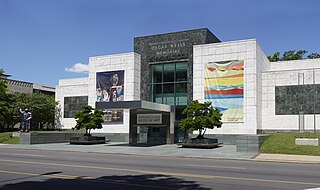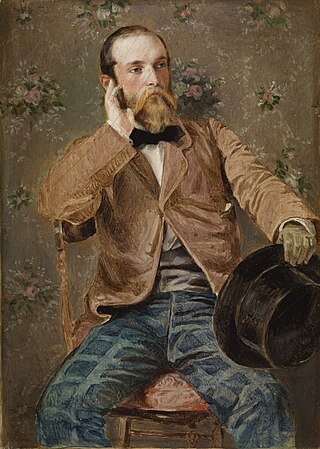
Emanuel Gottlieb Leutze was a German-American history painter best known for his 1851 painting Washington Crossing the Delaware. He is associated with the Düsseldorf school of painting.

The Walker Art Center is a multidisciplinary contemporary art center in the Lowry Hill neighborhood of Minneapolis, Minnesota, United States. The Walker is one of the most-visited modern and contemporary art museums in the United States and, together with the adjacent Minneapolis Sculpture Garden and the Cowles Conservatory, it has an annual attendance of around 700,000 visitors. The museum's permanent collection includes over 13,000 modern and contemporary art pieces including books, costumes, drawings, media works, paintings, photography, prints, and sculpture.

The Saint Louis Art Museum (SLAM) is one of the principal U.S. art museums, with paintings, sculptures, cultural objects, and ancient masterpieces from all corners of the world. Its three-story building stands in Forest Park in St. Louis, Missouri, where it is visited by up to a half million people every year. Admission is free through a subsidy from the cultural tax district for St. Louis City and County.

The Minneapolis Institute of Art (Mia) is an arts museum located in Minneapolis, Minnesota, United States. Home to more than 90,000 works of art representing 5,000 years of world history, Mia is one of the largest art museums in the United States. Its permanent collection includes world-famous works that embody the highest levels of artistic achievement, spanning about 20,000 years and representing the world’s diverse cultures across six continents. The museum has seven curatorial areas: Arts of Africa & the Americas; Contemporary Art; Decorative Arts, Textiles & Sculpture; Asian Art; Paintings; Photography and New Media; and Prints and Drawings.

The Birmingham Museum of Art is a museum in Birmingham, Alabama. Its collection includes more than 24,000 paintings, sculptures, prints, drawings, and decorative arts representing various cultures, including Asian, European, American, African, Pre-Columbian, and Native American. The museum is also home to some Renaissance and Baroque paintings, sculptures,and decorative arts from the late 13th century to c. 1750.

The Samuel P. Harn Museum of Art is an art museum at the University of Florida in Gainesville, Florida. It is in the UF Cultural Plaza area in the southwest part of campus.

The Delaware Art Museum is an art museum located on the Kentmere Parkway in Wilmington, Delaware, which holds a collection of more than 12,000 objects. The museum was founded in 1912 as the Wilmington Society of the Fine Arts in honor of the artist Howard Pyle. The collection focuses on American art and illustration from the 19th to the 21st century, and on the English Pre-Raphaelite Brotherhood movement of the mid-19th century.
Mort Künstler is an American artist known for his illustrative paintings of historical events, especially of the American Civil War. He was a child prodigy, who, with encouragement from his parents, became a skilled artist by the time he was twelve. Today he is considered the "best-known and most respected historical artist in the country."
Robert H. Colescott was an American painter. He is known for satirical genre and crowd subjects, often conveying his exuberant, comical, or bitter reflections on being African American. He studied with Fernand Léger in Paris. Colescott's work is in many major public collections, including those of the Museum of Modern Art in New York, the Corcoran Gallery of Art, the San Francisco Museum of Modern Art, the Museum of Fine Arts, Boston, the Hirshhorn Museum and Sculpture Garden, the Baltimore Museum of Art and the Crystal Bridges Museum of American Art

Goshka Macuga is an artist based in London. She was one of the four nominees for the 2008 Turner Prize.
Lisa Nankivil is a contemporary American painter and printmaker.

Westward the Course of Empire Takes Its Way is a 20-by-30-foot painted mural displayed behind the western staircase of the House of Representatives chamber in the United States Capitol Building. The mural was painted by Emanuel Gottlieb Leutze in 1861 and symbolizes Manifest Destiny, the belief that the United States was destined for Western exploration and expansion originating from the initial colonies along the Atlantic seaboard to the Pacific Ocean. A study measuring 33+1⁄4 by 43+3⁄8 inches hangs in the Smithsonian American Art Museum.

William Dickinson Washington was an American painter and teacher of art. He is most famous for his painting The Burial of Latané, which became a symbol of the Lost Cause of the Confederacy in the years following the American Civil War, and for the work he did in establishing the fine arts program of the Virginia Military Institute.

Richard Caton Woodville was an American artist from Baltimore who spent his professional career in Europe, after studying in Düsseldorf under the direction of Karl Ferdinand Sohn. He died of an overdose of morphine in London at the age of 30. He was the father of Richard Caton Woodville Jr., also a noted artist. In his short career he produced fewer than 20 paintings; but they were well known in their time through exhibition and prints and have remained prominent in the canon of American painters.

The End of the Trail is a sculpture by James Earle Fraser located in Waupun, Wisconsin, United States. It depicts a weary Native American man hanging limp as his weary horse comes to the edge of the Pacific Ocean. The statue is a commentary on the damage Euro-American settlement inflicted upon Native Americans. The main figure embodies the suffering and exhaustion of people driven from their native lands.
Elizabeth Erickson is an American painter, feminist artist, poet, and educator. Her style of painting tends to gestural abstraction and the themes she explores occupy "the territories of ancient myth, religion, and spiritual feminism," according to art historian Joanna Inglot.
Jantje Visscher is an American painter, printmaker, photographer, sculptor, teacher, and mentor. Visscher uses geometry and mathematics to explore the dynamics of perception and optical effects through the use of nontraditional mixed media. She is from Minneapolis, MN, and is currently active among the WARM Mentor Program and the Traffic Zone Center for Visual Art. Visscher is best known for hard-edge abstraction and minimalism within her scientific approach and exploration of perception and mathematics.

Washington Crossing the Delaware is the title of three 1851 oil-on-canvas paintings by the German-American artist Emanuel Leutze.

The Passage of the Delaware is a large, Neoclassical 1819 oil-on-canvas painting by Thomas Sully. With attention to historical accuracy, the painting depicts George Washington on horseback observing the troops of the American Revolutionary Army in the process of crossing the Delaware River prior to the surprise attacks on Hessian troops on December 26, 1776, at the Battle of Trenton. The image is intended to capture the moment prior to George Washington dismounting his horse and joining his army in crossing the Delaware River.

Nyeema Morgan is an American interdisciplinary and conceptual artist. Working in drawing, sculpture and print media, her works focus on how meaning is constructed and communicated given complex socio-political systems. Born in Philadelphia, she earned her BFA from the Cooper Union School of Art and her MFA from the California College of the Arts. She has held artist residencies at the Skowhegan School of Painting and Sculpture and Smack Mellon. Morgan's works are in the permanent collections of the Bowdoin College Museum of Art and the Menil Collection.
















